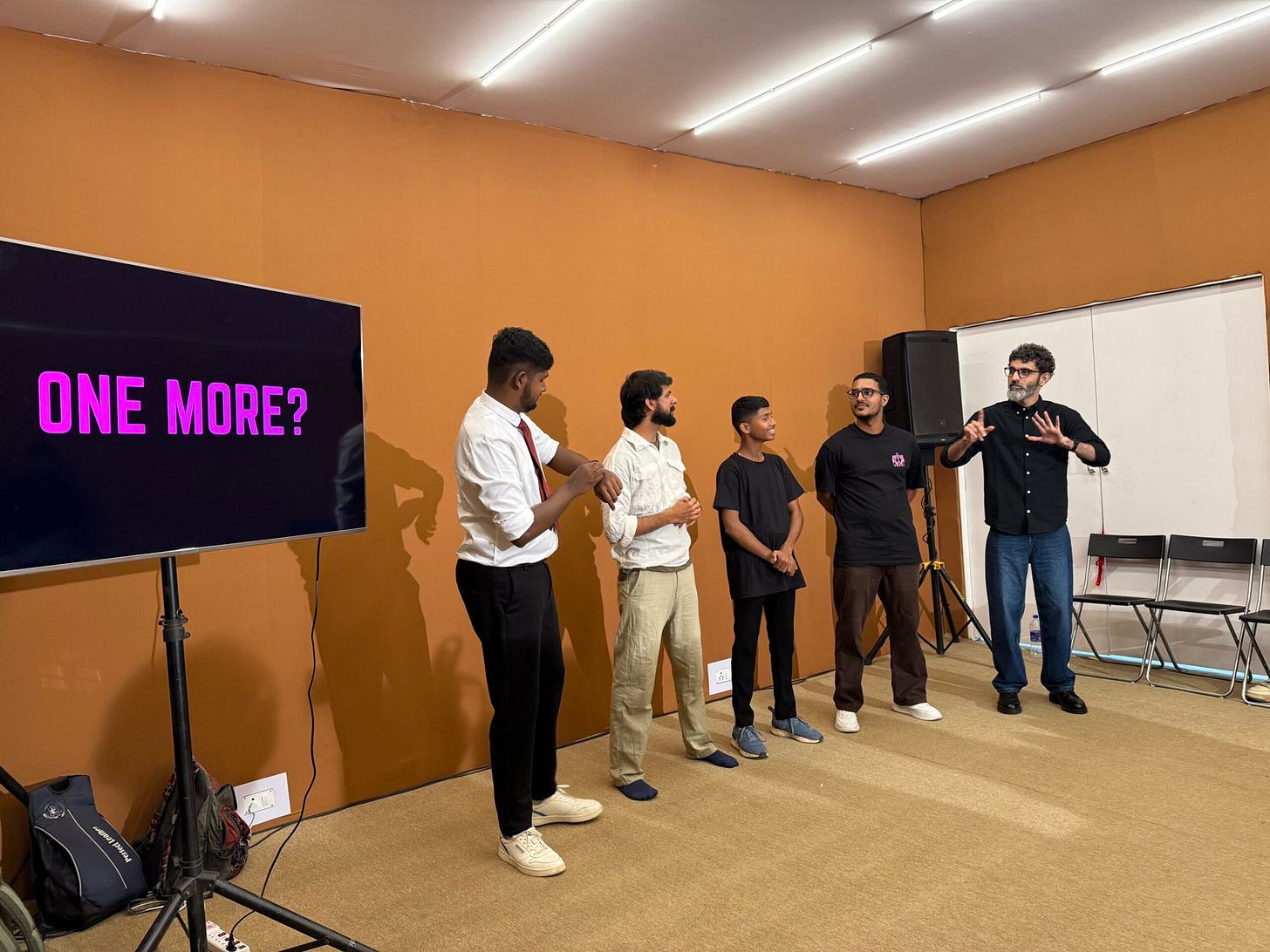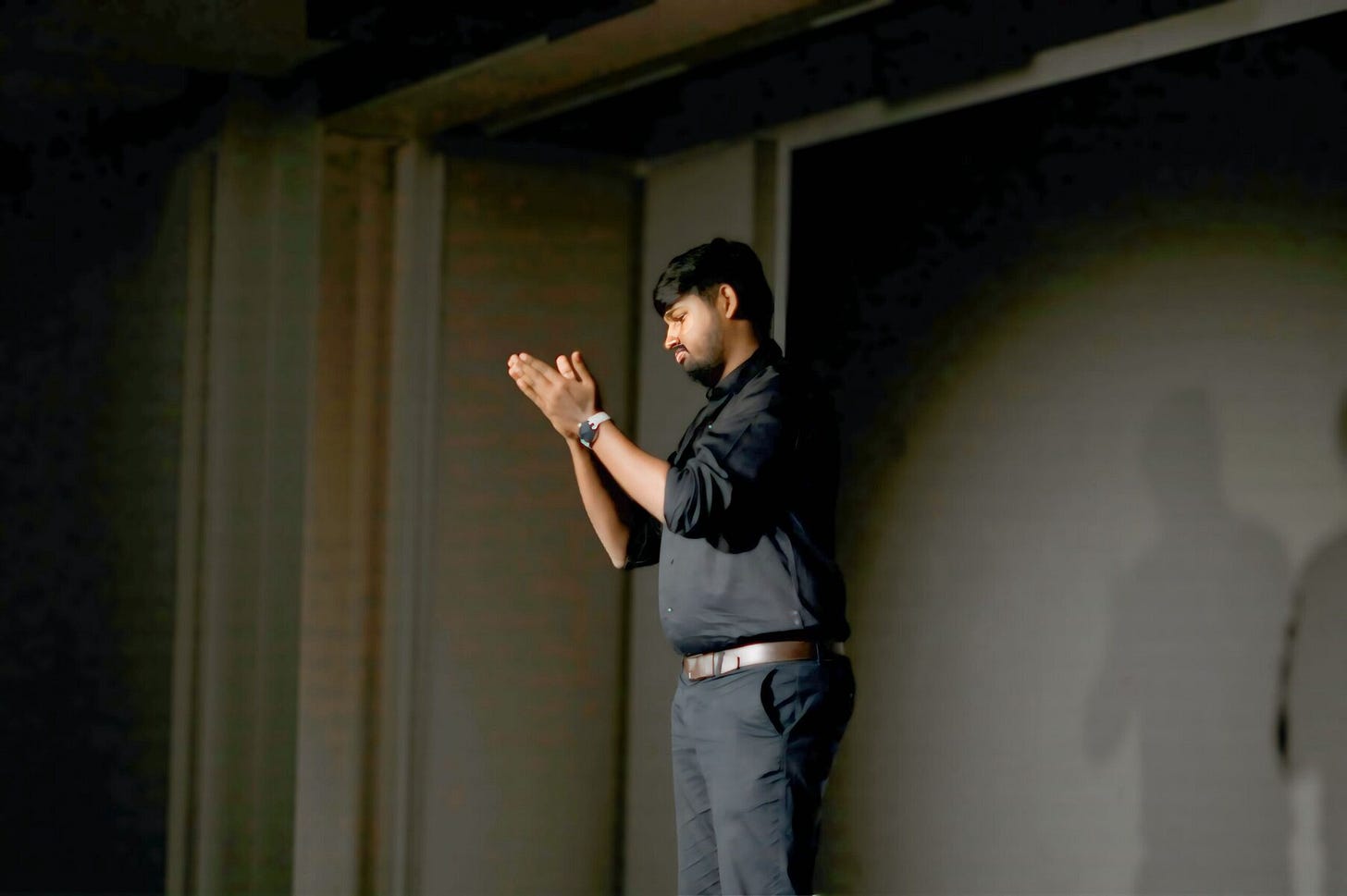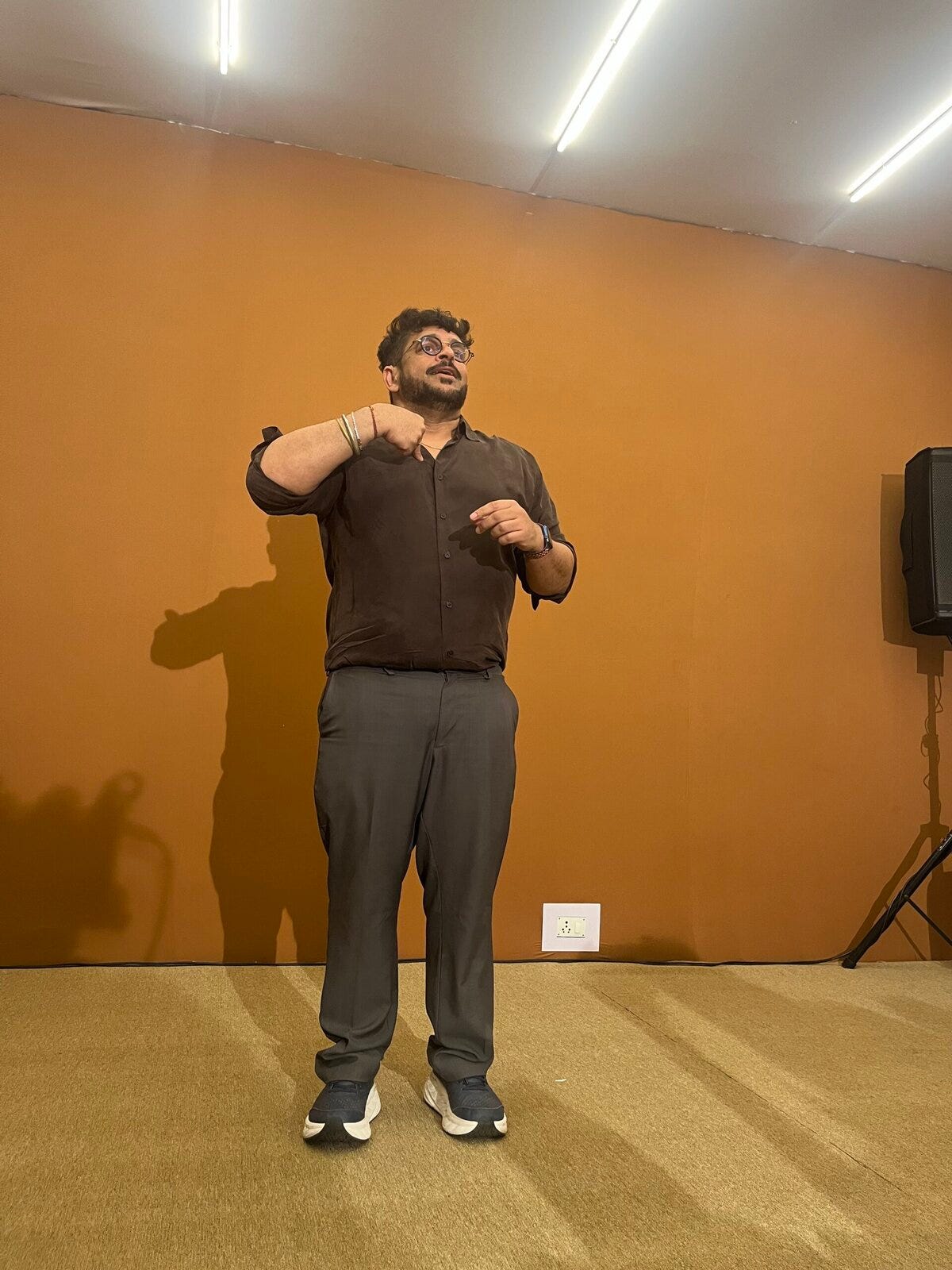Dear Readers,
Surprised to see an edition on a Thursday? This is a bonus issue, especially for all my Deaf friends and subscribers!
I recently wrote this story for Reasons to be Cheerful and my editor kindly permitted me to republish it in Reframing Disability!
As a big thanks to all the Deaf people who made this story possible, I got it translated into Indian Sign Language by Deepak KC, a Bengaluru-based Deaf artist! And what a wonderful job he has done in the 18-minute video. Reply to this email and I’ll let him know your feedback!
[ID for the logo: “On a bright purple background two white hand illustrations form an open rectangular frame. Inside the frame, the words ‘Reframing Disability’ are written in white text, symbolising a fresh perspective on disability.”]
An Art Form That Makes Silent Voices Heard
In a room packed with attentive audience members, Benin Varghese stands in the center of the scene, fully immersed in his performance. His tongue sticking out slightly, he extends his right hand forward, then his left, mimicking the cautious, deliberate steps of a dog crossing the road.
Behind him, Soham Gaikwad stands close, both hands gently placed on the back of Varghese’s head, shaping them like floppy dog ears. The two move in sync, their collaboration bringing the imagined dog to life in a way that is both humorous and real.
Varghese and Gaikwad, who are both Deaf, recently brought this silent form of artistic expression to life at the Serendipity Arts Festival in Panjim, the capital of Goa, a coastal state in southwestern India.
[ID: In a room with brown walls and wall-to-wall carpet, the five artists (Deepak, Amaldev, Soham, Benin and Hardeep), are performing VV standing in a semi-circle. A large monitor on the left has bold purple text which reads “One More?”]
With gestures and mime rolled into one, this little-known art form, called Visual Vernacular (VV), is proudly used by the Deaf community for artistic expression. In VV, visual storytelling replaces formal signs, enabling people from both the Deaf and hearing communities to connect, understand each other and communicate without words.
In India, while Deaf artists are eager to showcase their art, there are very few welcoming, inclusive art spaces for them. A lack of familiarity among the hearing community with sign language and the access needs of d/Deaf people has resulted in inaccessibility not only in art and cultural spaces, but also in education and employment. This gap in knowledge among hearing people limits interaction between the hearing and Deaf communities and is also a barrier to current advocacy efforts to make Indian Sign Language (ISL) the 23rd official language of India.
Alim Chandani is a Deaf activist working to integrate Deaf artists into the mainstream art scene in India. As the mission leader of Hear A Million, a project by the NGO Enable India that helps the Deaf community to lead productive lives, and the founder of the social enterprise Freedom to Sign, Chandani is bringing together Deaf artists and supporting them in honing their skills in VV and other forms of art including photography, painting, filmmaking, and poetry.
VV is still an emerging art in India, but it is as old as The Beatles. It is said to date back to the 1960s in the United States, when Deaf artist Bernard Bragg began blending mime techniques with American Sign Language. Over the years, Bragg’s innovative art has spread worldwide, gaining popularity in countries like Denmark, Germany and the United Kingdom. Joel Ortiz, a VV artist and founder of Joz Studio based in Orlando, Florida, says that across the globe, VV is being used not only as an art, but also “for activism and cultural expression.”
[ID: Dressed in black shirt and trousers, Deepak, an Indian man with dark hair and a beard, in a shot taken from his left, has both his hands joined together in front of his chest, performing VV on a stage.]
“The unique nature of VV allows it to transcend language barriers, making it accessible and relatable to people from all countries and cultures,” Ortiz says. The surge in online visibility, he says, “has accelerated the growth of the VV movement, allowing artists to reach a much larger audience and collaborate across borders.”
In India, scattered and invisible, Deaf VV artists have long worked in silos.
Chandani was mindful of this disconnection. In March of last year, when he started planning Hear A Million’s first Deaf-led curation in Bengaluru for Deaf Awareness Month (September), he created a Deaf Artists Collective to bring the artists together. Seeing their interest in VV, he arranged for and personally financed a two-hour workshop by Ortiz to help them hone their skills.
“I always thought I could act well, that I have good expressions, but after attending the workshop I realized that VV is more than that, ” says Deepak KC, a VV artist from Bengaluru, who attended the workshop.
“The workshop gave me insights into all the tools required for VV: hand shapes, body movements, transitioning techniques, and connecting them all to tell a story. Once I learned all this I could improve my VV skills tremendously.”
Chandani’s curation, including the VV show, held in September, was the first of its kind in Bengaluru showcasing Deaf artists. It was well-attended by Deaf and hard of hearing audiences, who connected deeply with the art.
Many Deaf visitors see art galleries and performance spaces as reserved for the elite or upper class, Chandani says. “This inclusive space we created — with sign language interpretation and Deaf artists — was an icebreaker, encouraging them to step into art galleries, explore visual storytelling, and engage with art as an educational and cultural medium,” he adds.
[ID: Dressed in black shirt and trousers and black and white sneakers, Alim Chandani, a bespectacled Indian man with dark curly hair and a beard is standing and signing to an invisible audience. The room has brown walls and a wall-to-wall carpet.]
Hearing audiences are captivated by VV. Nishna Mehta, a hearing practitioner of theater for young audiences, says that VV bridges the communication gap between the hearing and Deaf communities. “I’m drawn to VV because it is aesthetically so beautiful.”
Mehta is exploring ways to use VV for accessibility in children’s theatre because “it is accessible, regardless of whether you know sign language or not.”
“As someone who uses language a lot for poetry and other kinds of writing, it was fascinating for me to see what the gestural aspect of VV is about and how the body comes into play in a poetic kind of way,” says wheelchair-using hearing artist and poet Salil Chaturvedi, a curator at the recent Serendipity Arts Festival.
Chandani has always been passionate about arts and design, a career he wasn’t encouraged to pursue as “the arts aren’t considered financially promising.” But in recent years, having heard firsthand the struggles of Deaf people who want to pursue the arts as a career, “I didn’t want them to face the same discouragement,” he says.
The historical neglect of the Deaf community has “not only suppressed our ability to express emotions through art but also led to our talents being exploited as token gestures,” Chandani says. While doing these shows and creating art spaces is meant to bring Deaf artists and performers into the mainstream art world, it is also one of the ways for them to advocate for sign language to become an official language in India, Chandani says.
Often, Deaf artists are not aware that the art they casually practice is VV. Eighteen-year old Gaikwad, one of the Serendipity Arts Festival performers, didn’t know it either, until he met Varghese, who helped him develop his skills. “Now I want to pursue VV seriously, even as a profession, if I get paid for it,” says Gaikwad.
Deaf poet Hardeep Singh says that growing up, he was never exposed to sign language poetry or VV. Deaf children are luckier today, he notes, because they get to see artists who are getting a chance to perform. “The more we showcase these forms of art, the more skilled today’s deaf kids will be when they grow up,” he says.
Despite some success, VV has so far had limited reach in India, being performed only in select cities that conduct art festivals or have art spaces.
Even some of the premier art exhibitions lag behind: The India Art Fair, held in January in New Delhi, did not have a single Deaf artist this year. Chandani says that art festivals should actively recruit Deaf and disabled artists rather than “merely claiming accessibility as an achievement.”
For art spaces, ensuring accessibility requires both thoughtful planning and funds. Sign language interpreters, translation of information into ISL and captioning for exhibitions and events come at a cost.
Sign language interpretation of art and performances requires a unique approach to convey the nuances, says Chandani. “But many interpreters are not equipped with these specialized skills and need additional training,” he notes.
This story originally appeared in Reasons to be Cheerful.
What do you think about Visual Vernacular? Did you like this story? Is VV popular in your country? Let me know your thoughts. Hit reply or find me on LinkedIn and Instagram or connect with Reframing Disability on Instagram.
Hire me
Want to commission more stories like this one?
I’m a journalist and researcher: My byline appears in the BBC, Guardian, The Lancet, The British Medical Journal, CNN, Stanford Social Innovation Review and the Reuters Institute for the Study of Journalism. Check my portfolio for my recent work. I’m open to commissions.
I conduct training/workshops on solutions journalism, disability inclusion and accessibility in communications, storytelling, and all kinds of content. Write to me for a customised training for your organisation.
Book a 15-minute free call with me on Topmate to discuss how we can work together.
See you in your inbox in two weeks!
Warmly,
Priti








Share this post